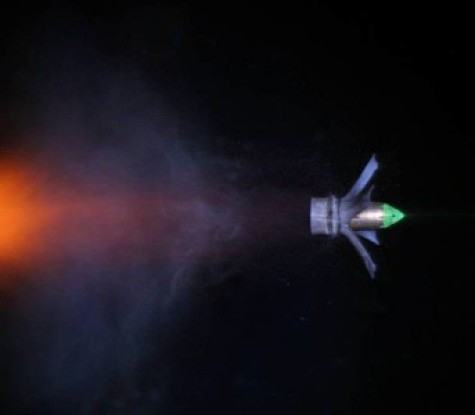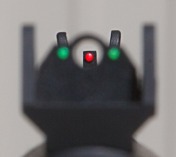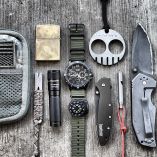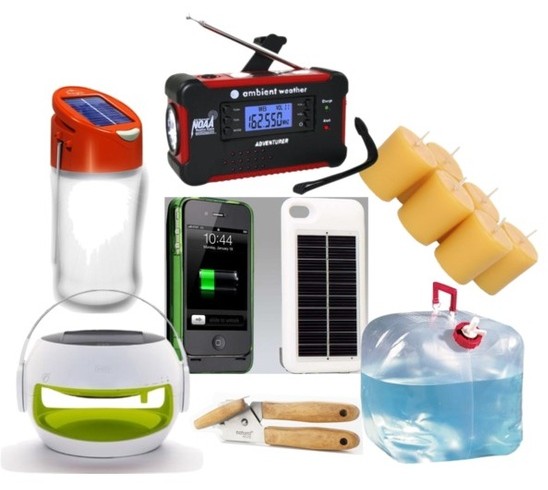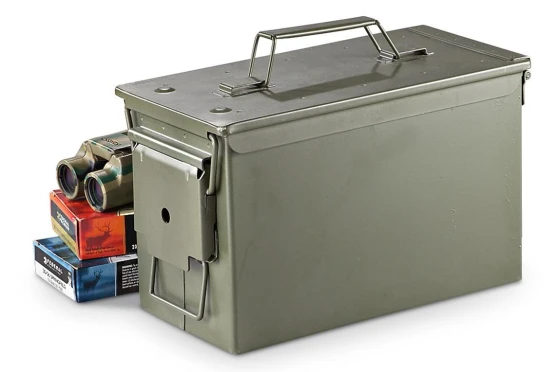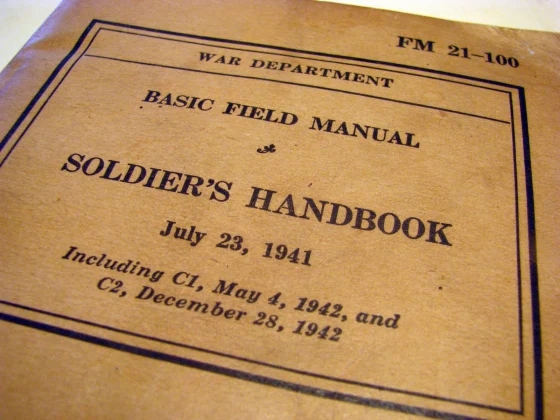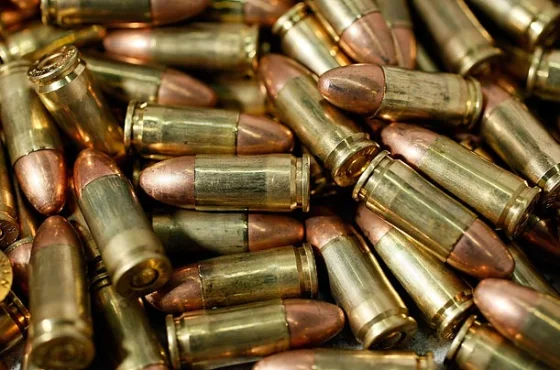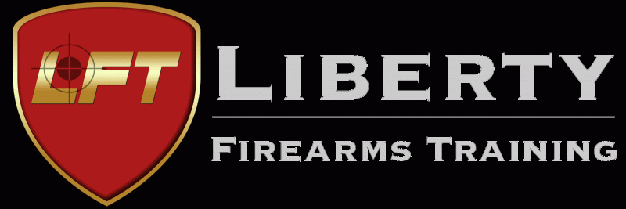“I got a shotgun, a rifle, and a 4-wheel drive. A country boy can survive.”
– Hank Williams Jr. –
Contents:
Tactical Shotgun Essentials:
- Introduction to the Tactical Shotgun
- Shotgun Safety
- Shotgun Gauge
- Pump Action vs. Semi-Auto
- Types of Shotgun Barrels — Smooth Bore vs. Rifled
- Shotgun Barrel Length And Projectile Velocity
- Shotgun Chokes
- Shotgun Tiers of Quality
- Shotshell Revolvers
- Manuals in PDF Format
Shotgun Ammunition
- Introduction To Shotgun Ammunition
- Shotshell Parts & Markings
- Birdshot
- Buckshot
- Rifled Slugs
- Sabot Slugs
- Shotshell Length — 2.75″ vs. 3″ Shells
- High-Brass vs. Low-Brass
- Reduced Recoil Shotshells
- Specialty Rounds
Tactical Shotgun Accessories:
- Shotgun Accessories Philosophy
- Side-Saddle
- Dedicated Weapons Light
- Mounted Tactical Light
- Shotgun Pistol Grips
- Shotgun Stocks
- Slings
- Rifled Sights
- Qualtiy Gear
- Shotgun Setup Examples
- Tactical Shotgun Recommended Setup
Tactical Shotgun Operation:
- General Pump Action Shotgun Operation
- How To Aim A Shotgun
- How To Store A Loaded Home Defense Shotgun
- How To Load A Pump-Action Shotgun
- Pump-Action Emergency Reloads
- How To Unload A Pump-Action Shotgun
- Close Quarters Shotgun Technique
- Techniques For Mitigating Recoil
- Shotgun Practice Drills
Introduction to the Tactical Shotgun:
Shotguns can be used for self-defense, deer hunting, or bird hunting. The following information regards the use of a shotgun in the roll of self-defense.
Shotguns are not Claymore mines. While they are also not precision weapons, you can’t just close your eyes and point the shotgun in the general direction of the target and expect to have favorable results.
With a cylinder bore barrel, you can expect the shot pattern to spread one inch for every yard of travel from the end of the barrel. After 15 yards the pellets have spread out enough that few pellets will hit the target, and those that do will not have enough terminal energy left to stop the target (except Murphy’s Law says that errant pellets will have plenty of energy to kill innocent bystanders behind the intended target).
Effective range of a shotgun with buckshot is 15-20 yards. With rifled slugs and rifled sights on your shotgun you can accurately engage man size targets out to 100 yards.
- Lucky Gunner’s Is the Defensive Shotgun Still Relevant?
- Lucky Gunner’s I Use To Hate Shotguns But Now I Don’t
- Lucky Gunner’s Dispelling Myths of the 12 Gauge Shotgun
- Get Zone’s Home Defense Shotguns: What You Need To Know
back to top
Shotgun Safety:
Don’t Trust Shotgun Safety:
back to top
Shotgun “Gauge”:
What is Gauge?
The “caliber” of rifle and handgun ammunition refers to the diameter of the bullet in 100th or 1000th of an inch. The bigger the caliber, the wider the bullet.
Shotguns are different. Instead of caliber, shotguns barrel diameter is expressed by “gauge”. Gauge is defined as a unit of measurement used to express the diameter of the barrel. It is determined from the weight of a solid sphere of lead that will fit the bore of the firearm, and is expressed as the multiplicative inverse of the sphere’s weight as a fraction of a pound (e.g., a 1⁄12th pound ball fits a 12-gauge bore). Thus there are twelve 12-gauge balls per pound (etc.).
Therefore the bigger the gauge of a shotgun, the smaller the diameter of the shotgun shell. (So 28 gauge is smaller than 20 gauge, which is smaller than 16 gauge, which is smaller than 12 gauge, which is smaller than 10 gauge, which is smaller than 8 gauge.)
12 Gauge — The Gold Standard:
12 gauge is the standard for combat/defensive shotguns. 12 gauge makes up 50% of the shotgun market in the U.S.
20 Gauge:
The great majority of combat/defensive shotguns are made in 12 gauge, with a few made in 20 gauge. 20 gauge may be used by smaller frame or disabled shooters, however it lacks the kick-ass factor of 12 gauge. Anything smaller than 20 gauge is not appropriate for self-defense.
28, 16, 10, and 8 Gauge — Non-Traditional Defensive Gauges:
28 gauge, 16 gauge, 10 gauge, and 8 gauge shotguns are for hunting. There aren’t any over-the-counter combat / defensive shotguns in these sizes that I am aware of. Most of these gauges of ammo are fairly obscure and not readily available Wal-Mart, and since the ease of proliferation is one of my criteria in the selection of a defensive weapons system, I would not consider one these for defense.
.410 (caliber, not gauge):
.410 is the smallest size shotgun. After all the discussion on the definition of gauge, it is interesting to note that “.410” is actually the caliber of the shotgun rather than the gauge. .410’s have very little recoil and are good for teaching young shooters the fundamentals of shooting shotguns, and for taking care of snakes and rodents at close range. It is generally not adequate for self-defense, although I don’t know of anyone that wants to be shot with one.
back to top
Pump Action vs. Semi-Auto Action:
Semi-autos can be very finicky about the ammo that they will shoot. Lighter powered loads may not cycle the gun.
With a pump-action shotgun the shooter cycles the action, so it will shoot any type of shotgun shell.
Semi-autos are much more susceptible to malfunctioning due to being dirty than a pump-action. Where as the same amount of fouling in a semi-auto may jam up the action, the shooter of a pump-action can force the action through the fouling and still shoot.
When you fire a semi-auto shotgun, the next round is automatically loaded into the chamber. With a pump-action you can choose whether or not to reload after you have fired. This makes it easy should you decide to change types of ammo while shooting (you are shooting buckshot, but need the next round to be a breeching round to open a locked door or a slug for a long-range shot). Load the round in the tubular magazine, work the action, and that round is chambered and ready to fire.
Traditionally both pump-action and semi-autos shotguns have been limited to between three to nine rounds, depending on the model and the modifications, and are stored in a tubular magazine that runs along the bottom of the barrel. Neither types have been quick to reload. Russian built “Saiga” box-magazine fed shotguns have recently been introduced in the United States. They hold a greater number of rounds, and can be reloaded very quickly. They will shoot most buckshot loads, as well as rifled slugs.
Parts and Operation of a Pump Action Shotgun:
Parts of a Semi-Auto Shotgun:
Coming soon.
back to top
Type of Shotgun Barrels — Smooth Bore vs. Rifled:
Smooth, or Cylinder Bore:
These barrels are exactly what they are called. They are smooth inside and have no rifled grooves. You can shoot any type of shotgun ammo out of them. Some barrels are designed so that you can add a “choke” which constricts the end of the barrel and holds the pattern of shot in a tighter pattern out to a slightly farther distance. You can accurately shoot rifled slugs out of the smooth barrels. Where as on a pistol or rifle the projectile is smooth and the barrel has grooves, on the shotgun the barrel is smooth and the projectile is grooved. The results are the same. Don’t shoot slugs from a barrel with a choke. Damage will occur.
Rifled:
These barrels have rifled lands and grooves. They are designed to accurately shoot sabot rounds. It is not recommended to shoot birdshot or buckshot, as that will wear out the grooves in the barrel. Also, as the plastic cup containing the shot travels through the barrel, the rifled groves will put a spin on the cup. When the spinning cup of shot leaves the barrel the spinning action will sling the shot and widen the pattern and thus lessening the effective range of the weapon. These barrels are great to use for deer hunting. You can use it in a self-defense, but you will be severely limited as to what type of ammo you can use.
back to top
Shotgun Barrel Length And Projectile Velocity:
The minimum length that you can legally own without going through a bunch of BATFE red tape is 18 inches. With this length of barrel you can expect the tubular magazine to hold five to seven rounds. Some combat shotguns have 20 inch barrels. You can expect the magazine tube to hold around eight rounds.
As a general rule, the longer the barrel is, the tighter the shot pattern will maintain over a given distance. This is important with hunting, however in self-defense engagements at close distances it may be desirable to have the pellets spread so as to “spread the trauma”.
Also as another general rule, as a firearm’s barrel length is reduced, so is the projectile’s velocity.
back to top
Shotgun Chokes:
A “Cylinder Bore” choke is nothing but a straight barrel with no choke at all. It is safe to shoot rifled slugs out of a cylinder bore choke barrel, however the slug may not grip the inside walls of the barrel enough to create enough spin to appropriately stabilize it.
An “Improved Cylinder” choke will provide the best spin stabilization for rifled slugs fired from a smooth-bore barrel. The choke diameter is large enough to let the slug pass through without damaging the choke, but the slug will pass through just snug enough to give the rifled groves on the slug enough to grip and help spin stabilize it.
Several rifled slug manufacturers state that their slugs are safe to shoot through any type of choke, however as you can see in the video below, any choke other than “Improved Cylinder” will damage or prematurely wear out the choke. It is best to avoid shooting slugs out of a “Modified Choke”, “Improved Modified”, or a “Full Choke”.
back to top
Shotgun Tiers of Quality:
Tier One Shotguns:
- Remington 870
- Mossberg 590 / 590A1
- H&K / Benelli
Tier Two Shotguns:
- Remington 870 Express
- Mossberg 500
- Winchester 1300
- Saiga
Tier Three “Economy” Shotguns:
- Mossberg Maverick shotguns
- Saiga (requires extensive gunsmith work to make reliable)
back to top
Smith & Wesson Governor and Taurus Judge .410 Revolvers:
Toys, Or Serious Fighting Tools?
Smith & Wesson and Taurus both make revolvers capable of firing .410 gauge shotgun shells as well as .45 Colt and .45 ACP (in moon clips). The Smith & Wesson Governor holds six rounds of ammunition and the Taurus Judge holds five. The are both considered handguns rather than short-barrel shotguns because the barrels are rifled. If they were smooth-bore they would require the owner to register them as a short-barrel shotgun with the BATFE, and pay $200 for a tax stamp from the Treasury Department (as with machine guns and suppressors).
In my humble opinion (and I’m sure that there are many people who will disagree with me) I consider these firearms to be novelties and not serious self-defense gear. But wait?! It’s a shotgun! How can it not be a serious fighting tool? First, the .410, whether you use rifled slugs, buckshot, or birdshot, is a pathetically anemic performer out of a full barred shotgun. If you fire it out of a two to four-inch barrel you will be getting only a small fraction of what little potential stopping power that the round can offer. The shotgun rounds will only be effective at very close range. If you want to shoot any distance farther than 10 yards will have to shoot the .45 Long Colt or .45 ACP (on moon clips) handgun ammunition. Rather than shoot .45 Colt or .45 ACP ammunition out of the giant revolver, I’d rather shoot them out of a firearm specifically made for that ammo (and carry more rounds in the firearm with most .45 ACP offerings). If I want a shotgun I’ll shoot a 12 or 20 gauge regular size shotgun rather than .410 out of a “micro barrel”.
Of course I don’t want to be shot with one of these revolvers, but when I’m analyzing what is going to be the most effective handgun (in terms of stopping power and cost) for me to purchase and carry, these .410 revolvers don’t add up. Please feel free to scroll down to the bottom of the page and post friendly and informative comments with any of your experience with these firearms. I’d love to hear them. You might convince me to give them another chance.
back to top
Shotgun Manuals in PDF Format:
- Mossberg-500 Manual in PDF
- Remington 870 Manual in PDF
- Remington 1100 / 1187 Manual in PDF
- Winchester Model 1300 Manual in PDF
- Ithaca Owners Manual in PDF
- Franchi Spas-12 Manual in PDF
back to top
“Just fire the shotgun through the door.”
– Joe Biden: Vice President of the United States of America –
Introduction To Shotgun Ammunition:
back to top
Shotshell Parts and Markings:
Shotgun shells have five basic parts:
- The hull or shellcase
- Primer
- Gunpowder
- Wad or shot cup
- Projectile (Shot, pellets, or slug)
back to top
Types of Shotgun Shells:
The three most popular types of shotgun shells are:
- “Birdshot”
- “Buckshot”
- “Slugs” (sabot slugs or rifled slugs)
There are also many types of specialty rounds which include flares, CS, incendiary, etc.
back to top
Birdshot:
 Birdshot (as seen on the left in the photo below) fires a dense cloud of very fine pellets and is intended for shooting flying birds or sporting clays. There are different size shot for different applications (as seen right). The smaller the numbering of the shot, the finer the pellets and the greater the number of pellets that can be crammed into the same shotgun shell. (#8 shot is the finest birdshot, and is finer than #6 shot, which is finer than #4 shot.) There are also heavier shot loads intended for hunting duck and geese. Note that the smaller the shot, the less mass each pellet will have, which will result in less kinetic energy on the target and less effective range of the pellet. Hunting thick feathered geese will require heavier pellets than hunting dove or quail. Birdshot is very deadly at close range, but it quickly looses its energy and becomes an ineffective defensive round.
Birdshot (as seen on the left in the photo below) fires a dense cloud of very fine pellets and is intended for shooting flying birds or sporting clays. There are different size shot for different applications (as seen right). The smaller the numbering of the shot, the finer the pellets and the greater the number of pellets that can be crammed into the same shotgun shell. (#8 shot is the finest birdshot, and is finer than #6 shot, which is finer than #4 shot.) There are also heavier shot loads intended for hunting duck and geese. Note that the smaller the shot, the less mass each pellet will have, which will result in less kinetic energy on the target and less effective range of the pellet. Hunting thick feathered geese will require heavier pellets than hunting dove or quail. Birdshot is very deadly at close range, but it quickly looses its energy and becomes an ineffective defensive round.
Do not confuse birdshot with buckshot. For example, “#4 birdshot” is not the same as “#4 buckshot”. Buckshot is discussed next.
| Size | Pellets Per Ounce – Lead | Pellets Per Ounce – Steel | Ideal Use |
| BB | 50 | 72 | Geese |
| 1 | 72 | 103 | Geese |
| 2 | 87 | 125 | Ducks |
| 3 | 108 | 158 | Ducks |
| 4 | 135 | 192 | Turkey |
| 5 | 170 | 243 | Turkey |
| 6 | 225 | 315 | Squirrel |
| 7 | 290 | N/A | Pheasant |
| 7 1/2 | 350 | N/A | Quail |
| 8 | 410 | N/A | Dove |
| 8 1/2 | 497 | N/A | Trap |
| 9 | 585 | 892 | Trap |
back to top
Buckshot:
 Buckshot (as seen on the right in the photo above) is intended for deer hunting and self-defense. It is filled multiple round projectiles that when fired will hit the target simultaneously. Buckshot is made with different size projectiles, depending on the intended application. As with birdshot, the smaller the pellets, the more that can be loaded into the shell . As noted in the illustration to the right, the bigger the numbering of the shell, the smaller the projectiles. 000, or “triple aught”, has the largest size projectiles. 00, or “double-aught”, is the general self-defense load. With a 2 ¾” shell there are nine 33-caliber lead balls loaded inside. #4 shot has a greater quantity, but smaller lead balls. #4 buckshot is devastating at very close range, but quickly looses its energy. 00 buck is probably a better self-defense load.
Buckshot (as seen on the right in the photo above) is intended for deer hunting and self-defense. It is filled multiple round projectiles that when fired will hit the target simultaneously. Buckshot is made with different size projectiles, depending on the intended application. As with birdshot, the smaller the pellets, the more that can be loaded into the shell . As noted in the illustration to the right, the bigger the numbering of the shell, the smaller the projectiles. 000, or “triple aught”, has the largest size projectiles. 00, or “double-aught”, is the general self-defense load. With a 2 ¾” shell there are nine 33-caliber lead balls loaded inside. #4 shot has a greater quantity, but smaller lead balls. #4 buckshot is devastating at very close range, but quickly looses its energy. 00 buck is probably a better self-defense load.
| Size | Pellets Per Ounce – Lead | Diameter | Ideal Use |
| 000 | 6 | .36″ | Deer / Defense |
| 00 | 8 | .33″ | Deer / Defense |
| 1 | 19 | .32″ | Deer / Defense |
| 2 | 15 | .30″ | Deer / Defense |
| 3 | 18 | .25″ | Deer / Defense |
| 4 | 21 | .24″ | Deer / Defense |
With buckshot fired from a defense shotgun with cylinder bore choke you can expect the shot pattern to spread out one inch per each yard the shot travels. A hunting shotgun with a tighter choke will hold the pattern together for a longer distance. Buckshot is incredibly effective against unarmored targets at close quarters distance, but it quickly looses its stopping power after approximately 15 to 25 yards, and at that distance the pattern will be spread so much that you can not guarantee that all the pellets will hit the intended target and not hit an innocent.
12 gauge, 2 ¾” 00 buckshot is the gold standard in self-defensive shotgun ammunition. It has adequate stopping power within approximately 20 yards and has manageable recoil that still facilitates quick follow-up shots.
back to top
Rifled Slugs:
Rifled Slug Essentials:
 Rifled slugs are 1 ounce to 1 ¼ ounce lead projectiles that are spin stabilized like a bullet. Rifle and handgun bullets are smooth, but they are fired through rifled barrels which adds in-flight spin-stabilization to the projectile to increase accuracy (like when throwing a football). Most shotguns are smooth bore, so to increase accuracy the slugs themselves are rifled so as to spin as they travel down the smooth barrel and on to the target.
Rifled slugs are 1 ounce to 1 ¼ ounce lead projectiles that are spin stabilized like a bullet. Rifle and handgun bullets are smooth, but they are fired through rifled barrels which adds in-flight spin-stabilization to the projectile to increase accuracy (like when throwing a football). Most shotguns are smooth bore, so to increase accuracy the slugs themselves are rifled so as to spin as they travel down the smooth barrel and on to the target.
The rifled slug enables a smoothbore shotgun to be used as a bullet launcher and allows the shooter to stretch out the effective range and engage targets beyond shot or handgun. The slug can give the shooter impressive penetration through barriers or large mammals where buckshot might not drive deeply enough.
Rifled Slug Range and Accuracy:
Most smooth bore shotguns with a simple bead sight are capable of shooting a fist size group at 100 yards. At 50-yards it is unremarkable to shoot a group that has the giant holes touching. It is important to note that you will have different accuracy results when using different brands of ammunition. One brand may shoot tight groups from one shotgun, but looser groups in another. Test different brands to find which shoots best from your gun.
Whereas buckshot is only effective out to around 45 yards, rifled slugs increase the combat effectiveness of the shotgun out to as far as 125 yards. Beyond that the groups open up to a point where hit probability falls and the projectile starts to drop rapidly.
Inside 125 yards the slug flies an almost perfect match of the .357 Magnum or .44 Magnum pistol trajectory, both of which are considered flat-shooting, long-range handgun rounds. Zeroing the shotgun about an inch and a half high at 50 yards puts the slugs touching either side of the line of sight out to 100 yards.
Most bead-sighted shotguns are likely to have an approximate 100-yard zero, which runs about three to four inches high at the more common 50 to 75-yard distances, leading the unknowing to mistake trajectory for inaccuracy.
Rifled Slug Damage and Devastation:
The combination of huge mass (a 1-oz. slug is approximately 438 grains) and high velocity of the projectile (a respectable neighborhood of 1500-1600 feet per second), along with the fact that most are slugs are expanding, offers the shotgunner tremendous stopping power out to 125 yards. The shotgun slug has low sectional density and a large frontal area, slowing it quickly, but even as it crosses 125 yards, it is still a roughly .70 caliber bullet traveling at .45 ACP muzzle velocity. Even with “Low-Recoil” slugs, with a muzzle velocity of 1200-1350 feet-per-second, penetration at distance is likely to be through and through, especially if a harder slug is selected.
These rounds can be aimed fairly accurately with the bead sight on most shotguns, however when fired from a shotgun equipped with front and rear iron sights or a red-dot sight system, they can be aimed very accurately. Because of the limited distance that buckshot may be employed, many shotgun experts are recommending the strict use of slugs, as they can be used at close range and long distances (relative to shotguns).
The shooter must do the hard work of testing slugs in order to find the magic combination of acceptable recoil, accuracy, and point of impact relative to point of aim. If you are going to be using a semi-automatic shotgun you must do thorough testing of your intended slugs in order to verify reliable cycling. Test fire a batch of several different brands and see which you get the best results from. Then buy as much as you can and practice often.
Shooting Rifled Slugs With Chokes:
A “Cylinder Bore” choke is nothing but a straight barrel with no choke at all. It is safe to shoot rifled slugs out of a cylinder bore choke barrel, however the slug may not grip the inside walls of the barrel enough to create enough spin to appropriately stabilize it.
An “Improved Cylinder” choke will provide the best spin stabilization for rifled slugs fired from a smooth-bore barrel. The choke diameter is large enough to let the slug pass through without damaging the choke, but just snug enough to give the rifled groves on the slug enough to grip and help spin stabilize it.
Several rifled slug manufacturers state that their slugs are safe to shoot through any type of choke, however you can see in the video below that any choke other than “Improved Cylinder” will damage or prematurely wear out the choke. It is best to avoid shooting slugs out of a “Modified Choke”, “Improved Modified”, or a “Full Choke”.
back to top
Sabot Slugs:
 Sabot rounds (pronounced “say bo”) are smooth projectiles that are fired from special shotguns equipped with rifled barrels. The actual projectile is narrower than the barrel, but the projectile has a plastic sleeve around it that grips the groves of the barrel to induce spin, but then separate from the projectile via aerodynamic forces once it has departed the barrel. These rounds are very accurate when employed with a scope equipped shotgun. It is not recommended to shoot buckshot or birdshot out of sabot barrels as they will damage the rifling.
Sabot rounds (pronounced “say bo”) are smooth projectiles that are fired from special shotguns equipped with rifled barrels. The actual projectile is narrower than the barrel, but the projectile has a plastic sleeve around it that grips the groves of the barrel to induce spin, but then separate from the projectile via aerodynamic forces once it has departed the barrel. These rounds are very accurate when employed with a scope equipped shotgun. It is not recommended to shoot buckshot or birdshot out of sabot barrels as they will damage the rifling.
 Another option is to use a rifled choke on shotguns that are set up to accept chokes (such as bird hunting shotguns). The barrel is smooth, but just before the sabot exits the shotgun it passes through the choke and receives a stabilizing spin.
Another option is to use a rifled choke on shotguns that are set up to accept chokes (such as bird hunting shotguns). The barrel is smooth, but just before the sabot exits the shotgun it passes through the choke and receives a stabilizing spin.
back to top
Shotshell Length — 2.75″ vs 3″ Shells:
12 gauge ammo is either 2 3/4″ or 3″ long. The longer shells have more pellet and usually more propellant. While a little more powerful than the shorter rounds, their recoil is very abusive. Their slight increase in terminal performance on the target is not worth the recoil and abuse inflicted on the shooter and its negative effect on the ability to rapidly and accurately engage targets. Therefore 2 3/4″ shot shells and slugs are entirely adequate for combat shooting.
back to top
High-Brass vs. Low-Brass:
The brass part of a shotgun shell is where the gunpowder is located. Shown right, the shotgun shell shown on the left is referred to as “low-brass” and is usually associated with less powerful bird-shot and blanks. The shotgun shell on the right in the is referred to as “high-brass” and is usually associated with more powerful buckshot, rifled slugs, and sabot rounds (as these rounds require more propellant).
back to top
Reduced Recoil Shotshells:
Shotguns can be intimidating to shooters of a smaller stature. This has a negative effect on their ability to effectively use the weapon. Several ammo manufactures have developed “reduced recoil” shotgun ammo for buckshot as well as rifled slugs. This ammo uses slightly less propellant and has significant less recoil, however there is minimal decrease in terminal performance. Low-recoil slugs ten to be one ounce (approximately 438 grains) and depart the muzzle between 1200 and 1300 feet per second. The shotgun slug has low sectional density and large frontal area, slowing quickly, but even as it crosses 125 yards, it is still a roughly .70-caliber bullet traveling at .45 ACP muzzle velocity. Penetration with a low-recoil slug at distance is likely to be through and through, especially if a harder slug is selected. To sum it up: just about all of the kick-ass on the receiving end, with much less abuse to the shooter.
back to top
Specialty Rounds:
Aguila Mini-Shells:
Adaptors To Use Aguila Mini-Shells in Pump Action Shotguns:
Spoiler: Don’t trust your life to mini-shells in a pump action shotgun. Even with the adaptor they function too unreliably. Shoot them out of a break-open shotgun and have fun.
“Cut Shells” — Improvised Slugs:
A “cut shell” is an improvised solid slug. It is made from an inexpensive birdshot shell that has been modified so that the shot cup in the shell stays together and carries the load of birdshot to the target so that it hits as one mass of lead and not dozens of tiny pellets.
It is important that you use shotshells with one piece shot cups so that the shot remains together until impacting the target.
You should always check the barrel for obstructions after shooting a cut shell.
With an auto-loader or pump-action shotgun there is always a chance of the shell rupturing in the magazine tube or causing feeding problems. For reliability and ease of barrel obstruction inspection it is recommended that these only be fired from break-open shotguns.
Breaching Rounds:
Coming soon.
Less Than Lethal / Riot Control:
Coming soon.
“Dragon’s Breath” — Incendiary Rounds:
Flares:
Coming soon.
Bird Bombs:
Coming soon.
back to top
“Use a shotgun… and you don’t kill your kids.”
– Joe Biden: Vice President of the United States of America –
Shotgun Accessories Philosophy:
- AR15.com’s Setting Up Your Fighting Shotgun
- AR15.com’s Shotgun Picture Thread, part 1
- AR15.com’s Shotgun Picture Thread, part 2
- GetZone.com’s Pump Action Shotgun: Do’s & Don’ts When Choosing Accessories
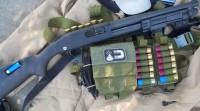 Like with all firearms I am a minimalist and don’t believe in adding a bunch of heavy, bulky, complicated junk. Unless it is quality gear that is going to help me shoot faster and more accurately, then it doesn’t belong on my gun. Just because you have a piano and fancy candelabra or two doesn’t make you a concert pianist. Adding a bunch of “tactical” looking crap doesn’t make the firearm more effective.
Like with all firearms I am a minimalist and don’t believe in adding a bunch of heavy, bulky, complicated junk. Unless it is quality gear that is going to help me shoot faster and more accurately, then it doesn’t belong on my gun. Just because you have a piano and fancy candelabra or two doesn’t make you a concert pianist. Adding a bunch of “tactical” looking crap doesn’t make the firearm more effective.
Although I am a minimalist I feel that two items will make it more effective. The first is some type of high-quality tactical light mounted to the gun, and the second is some type of “Side-Saddle” shell holder that fits on the side of the shotgun receiver.
back to top
Side-Saddle:
 A Side-Saddle (shown right) or similar type of device is handy for holding six extra rounds on the shotgun. They are made for several different models of shotguns, including the Mossberg 500/590 and the Remington 870. They are easy to install with no permanent alterations made to the firearm. With the Side-Saddle brand, I have found that if shells are loaded into it from the bottom, they are easier to remove and load into the gun, however rounds tend to vibrate out over time if you are shooting a lot. You will find yourself pushing the rounds back up into place. Loading them from the top solves that problem. Also, when installing the Side-Saddle, be sure to use Loctite on all the screws. Be sure to check the tightness of the screws after each shooting session as the screws like to vibrate out during prolonged shooting sessions.
A Side-Saddle (shown right) or similar type of device is handy for holding six extra rounds on the shotgun. They are made for several different models of shotguns, including the Mossberg 500/590 and the Remington 870. They are easy to install with no permanent alterations made to the firearm. With the Side-Saddle brand, I have found that if shells are loaded into it from the bottom, they are easier to remove and load into the gun, however rounds tend to vibrate out over time if you are shooting a lot. You will find yourself pushing the rounds back up into place. Loading them from the top solves that problem. Also, when installing the Side-Saddle, be sure to use Loctite on all the screws. Be sure to check the tightness of the screws after each shooting session as the screws like to vibrate out during prolonged shooting sessions.
back to top
Dedicated Weapons Light:
Most self-defense shootings happen in low light, and some type of tactical illumination tool is mandatory to properly identify whether or not you are shooting a “hostile”, or about to accidentally shoot a “friendly”. Adding a light to a shotgun will give you the capability to employ it at night or inside dark buildings. You are going to have to spend some money to do this right. Put a budget light and mount on a shotgun is going to result in disappointment. I can’t think of anything more abusive than being bolted to the side of shotgun firing full power rounds. If you go cheap, either the mount or the light is going to break. Surefire (shown right) makes dedicated shotgun forends for Mossberg 500/590 and Remington 870 shotguns. They are built specifically to handle that shock and abuse.
back to top
Mounted Tactical Light:
Coming soon.
back to top
Shotgun Pistol Grips:
- Savannah Arsenal’s Shotgun Pistol Grip Blog
- Guns America’s Pistol Grip Pitfalls (and How to Avoid Them)
There are many mixed feelings and emotions about pistol grip shotguns. Many argue that they are not effective defensive weapons because they are harder to aim and safely control than shotguns equipped with a shoulder stock. Others argue that a pistol grip shotgun provides the shooter a massive amount of close range firepower in a compact package that easy to transport in a vehicle, boat, or backpack. In my opinion everyone is correct. Yes they can be more challenging to learn to shoot effectively without socking yourself in the nose, but with the lots of practice and appropriate ammunition the pistol grip shotgun can give you significant firepower in you vehicle, boat, or at your campsite or bedside.
I owned and frequently shot a Mossberg 500 with a factory pistol grip way before I had the benefit of the internet armchair commandos on YouTube and gun forums telling me that I could not accurately shoot a pistol grip shotgun. Since I didn’t have the benefit of someone telling me that I couldn’t do it, I practices until I could. I have no problem hitting a man-size target in the chest at 35 yards with 00 buckshot.
Savannah Arsenal recommends the Shockwave Technologies Raptor Grip, Hogue Tamer Grip, or Tac Star’s gen-2 rear tactical grip for Mossberg 500/590 and Remington 870 shotguns when a compact, pistol grip configuration is sought after.
back to top
Shotgun Stocks:
Conventional Stocks:
 They work great with either Mossberg or Remington safety switches. With Mossberg shotguns it is easy to use your thumb to move the tang safety switch, and with Remington shotguns it is easy to manipulate the trigger guard safety.
They work great with either Mossberg or Remington safety switches. With Mossberg shotguns it is easy to use your thumb to move the tang safety switch, and with Remington shotguns it is easy to manipulate the trigger guard safety.
Speedfeed Stocks:
Pistol Grip Stocks:
 Pistol grips stocks (shown right) make shotguns very controllable. On a Mossberg shotgun a pistol grip stock may make accessing the tang safety switch on the top of Mossberg’s receivers a little more problematic, although not impossible. They work great with Remington safeties.
Pistol grips stocks (shown right) make shotguns very controllable. On a Mossberg shotgun a pistol grip stock may make accessing the tang safety switch on the top of Mossberg’s receivers a little more problematic, although not impossible. They work great with Remington safeties.
Magpul SGA Stocks:
- SA’s Review of Magpul’s SGA Stock For Shotguns
- Magpul SGA for Mossberg 500/590
- Magpul SGA for Remington 870
 These stocks, available for Mossberg 500/590 and Remington 870 shotguns, are a hybrid between a standard stock and a pistol grip stock. Regardless of perceived aesthetics they are extremely comfortable and they are easy to use with Mossberg and Remington safeties. They are available in black, “stealth grey”, FDE, and “Less-Lethal Orange”.
These stocks, available for Mossberg 500/590 and Remington 870 shotguns, are a hybrid between a standard stock and a pistol grip stock. Regardless of perceived aesthetics they are extremely comfortable and they are easy to use with Mossberg and Remington safeties. They are available in black, “stealth grey”, FDE, and “Less-Lethal Orange”.
 There is a matching forend for the Magpul SGA Stock, as seen right. There are models for the Mossberg 500/590 and the Remington 870. It is very comfortable and gives you a lot to hold on to. Unfortunately it is not designed for use with a heat shroud mounted to the barrel, although I have know someone to carefully sand off enough material that it did not interfere with the shroud. My recommendation would be to not modify the forend, but rather remove the heat shroud. When holding the forend you won’t have any problems with your booger pickers touching the hot barrel. The forend wraps high enough around the barrel that you probably can’t reach up far enough to accidentally touch the barrel.
There is a matching forend for the Magpul SGA Stock, as seen right. There are models for the Mossberg 500/590 and the Remington 870. It is very comfortable and gives you a lot to hold on to. Unfortunately it is not designed for use with a heat shroud mounted to the barrel, although I have know someone to carefully sand off enough material that it did not interfere with the shroud. My recommendation would be to not modify the forend, but rather remove the heat shroud. When holding the forend you won’t have any problems with your booger pickers touching the hot barrel. The forend wraps high enough around the barrel that you probably can’t reach up far enough to accidentally touch the barrel.
Top-Folding Shotgun Stocks:
Spoiler: They suck.
Top-Folding Shotgun Stock Philosophy: While super cool looking, these stocks are heavy, bulky, and they hurt your shoulder and your cheek when you shoot them. The benefit of having a more compact shotgun package is overshadowed by the diminished shootability of the shotgun. There are better shotgun stock options on the market. Rather than buying a top-folding stock, it would be better to spend the money on Magpul’s ergonomic SGA stock (discussed above), or simply use the fixed, factory stock that came with the shotgun and instead spend the money on ammunition and training. If you still can’t be persuaded from buying a top-folding shotgun stock, the following information will at least help guide your product selection.
 Choate Brand Top-Folding Stocks have that great, classic “police stake-out” look. Choate has made solid, quality shotgun stocks for many years. These stocks are made for Remington 870, Winchester 1200/1300/1400, and Mossberg 500/590 shotguns. This brand and model will probably be the most solid and quality built top-folding shotgun stock. If you are absolutely fixated with the idea of top-folding shotgun stock, then this is the one to buy.
Choate Brand Top-Folding Stocks have that great, classic “police stake-out” look. Choate has made solid, quality shotgun stocks for many years. These stocks are made for Remington 870, Winchester 1200/1300/1400, and Mossberg 500/590 shotguns. This brand and model will probably be the most solid and quality built top-folding shotgun stock. If you are absolutely fixated with the idea of top-folding shotgun stock, then this is the one to buy.
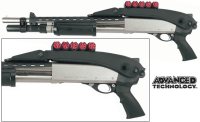 ATI brand accessories are sub-par and are cheaply made, except for their fixed pistol-grip stocks. Like all of their firearm accessories, the ATI top-folding stocks (shown right) are very cheesy, as are their barrel shrouds and receiver mounted shell holders. You won’t see any of their stuff running around Iraq or Afghanistan, or hopping out of the SWAT vans of American police departments.
ATI brand accessories are sub-par and are cheaply made, except for their fixed pistol-grip stocks. Like all of their firearm accessories, the ATI top-folding stocks (shown right) are very cheesy, as are their barrel shrouds and receiver mounted shell holders. You won’t see any of their stuff running around Iraq or Afghanistan, or hopping out of the SWAT vans of American police departments.
Side-Folding Shotgun Stocks:
Spoiler: They suck too.
Side-Folding Shotgun Stock Philosophy: Like top-folding stocks, side-folders look really cool, however they too are uncomfortable to shoot. Most brands are cheesy and the hinges rattle. There are better shotgun stock options on the market. Rather than buying a side-folding stock, it would be better to spend the money on Magpul’s ergonomic SGA stock (discussed above), or simply use the fixed, factory stock that came with the shotgun and instead spend the money on ammunition and training. If you still can’t be persuaded from buying a side-folding shotgun stock, the following information will at least help guide your product selection.
 Choate Brand Side-Folding Shotgun Stocks: Choate has made solid, quality shotgun stocks for many years. These stocks are made for Remington 870, Winchester 1200/1300/1400, and Mossberg 500/590 shotguns. This brand and model will probably be the most solid and quality built side-folding shotgun stock. If you are absolutely fixated with the idea of side-folding shotgun stock, then this is the one to buy.
Choate Brand Side-Folding Shotgun Stocks: Choate has made solid, quality shotgun stocks for many years. These stocks are made for Remington 870, Winchester 1200/1300/1400, and Mossberg 500/590 shotguns. This brand and model will probably be the most solid and quality built side-folding shotgun stock. If you are absolutely fixated with the idea of side-folding shotgun stock, then this is the one to buy.
 ATI Side-Folding Shotgun Stocks: Like their top-folding stocks, their side-folding stock is as cheesy as it is ugly. It has a M-4 style stock so that you can adjust length of pull, however all of the ridges along the tube and cheek pad look as though they could play havoc with your face. This stock has an ugly folding hinge that upon close inspection does not appear that it could survive a high round count of full power high-brass buckshot.
ATI Side-Folding Shotgun Stocks: Like their top-folding stocks, their side-folding stock is as cheesy as it is ugly. It has a M-4 style stock so that you can adjust length of pull, however all of the ridges along the tube and cheek pad look as though they could play havoc with your face. This stock has an ugly folding hinge that upon close inspection does not appear that it could survive a high round count of full power high-brass buckshot.
 Butler Creek folding stocks suck. Their hinge rattles with the stock closed or open. The wire stock is hard to get a good cheek weld, and it is painful on your cheek when you fire. Like ATI gear discussed above, you won’t find it kicking in doors in Iraq or Afghanistan.
Butler Creek folding stocks suck. Their hinge rattles with the stock closed or open. The wire stock is hard to get a good cheek weld, and it is painful on your cheek when you fire. Like ATI gear discussed above, you won’t find it kicking in doors in Iraq or Afghanistan.
Recoil Reducing Stocks:
Spoiler: They suck the worst.
 Blackhawk’s Knox Spec Ops Recoil Reducing Stock: I had one. I shot it a few times, and then sold it. This may or may not work well on a Remington. It works horribly on a Mossberg. Recoil is reduced to the shoulder, but if you are using appropriate cheek weld, it feels like you are being punched in the cheek. After four or five rounds you will not want to shoot the shotgun anymore. Also, the recoil forces the shotgun’s slide to shoot back at least half way with each shot, sometimes partially ejecting the spent round. This is a pain if the shooter doesn’t plan on ejecting the spent round and cycling a new round into the chamber. After you fire you are past the point of no return with regards to cycling the action and you must load the next round into the chamber. It is almost impossible to keep it from happening. This product is nothing more than a gimmick. As a shooter you need to man-up and deal with the recoil. It’s a shotgun, for God’s sake! Avoid this product. You have been warned.
Blackhawk’s Knox Spec Ops Recoil Reducing Stock: I had one. I shot it a few times, and then sold it. This may or may not work well on a Remington. It works horribly on a Mossberg. Recoil is reduced to the shoulder, but if you are using appropriate cheek weld, it feels like you are being punched in the cheek. After four or five rounds you will not want to shoot the shotgun anymore. Also, the recoil forces the shotgun’s slide to shoot back at least half way with each shot, sometimes partially ejecting the spent round. This is a pain if the shooter doesn’t plan on ejecting the spent round and cycling a new round into the chamber. After you fire you are past the point of no return with regards to cycling the action and you must load the next round into the chamber. It is almost impossible to keep it from happening. This product is nothing more than a gimmick. As a shooter you need to man-up and deal with the recoil. It’s a shotgun, for God’s sake! Avoid this product. You have been warned.
 Blackhawk also offers a wire version of the Spec Ops Recoil Reducing Stock. This thing looks dangerous to shoot. My face is way too pretty to even take a chance of shooting this thing.
Blackhawk also offers a wire version of the Spec Ops Recoil Reducing Stock. This thing looks dangerous to shoot. My face is way too pretty to even take a chance of shooting this thing.
back to top
Slings:
Don’t use a sling that carries ammo on it. While they look cool and can carry ten extra rounds on the gun, you will find that the weight of the sling with ten shotgun shells swinging back and forth and cause you trouble when taking carefully aimed shots, especially with rifled slugs. Carry ammunition in belt or chest pouches. There are quality bandoliers made by Blackhawk and Eagle Industries that carry 55 rounds of ammo. Carrying all that ammo is as easy as throwing the bandoliers over you head and shoulders.
back to top
Rifle Sights:
They will give you the ability to engage targets out to 100 yards with rifled slugs. When you are buying a shotgun, spend a little extra money and buy a shotgun with rifled sights. It will be cheaper than having them installed later.
Ghost Ring Sights:
Coming soon.
back to top
Tactical Shotgun Setup Examples:
 Mossberg 500 with factory 7-round tubular magazine, factory pistol grip, barrel shroud, and Side-Saddle shell carrier. Some people hate pistol grips on shotguns. They make them compact and easy to store and transport. They are fine to shoot buckshot at close quarters range, but it will be difficult to accurately shoot rifled slugs at greater distances.
Mossberg 500 with factory 7-round tubular magazine, factory pistol grip, barrel shroud, and Side-Saddle shell carrier. Some people hate pistol grips on shotguns. They make them compact and easy to store and transport. They are fine to shoot buckshot at close quarters range, but it will be difficult to accurately shoot rifled slugs at greater distances.
 Mossberg 590 with Marine-cote finish, factory 8-shot tubular magazine, Sure-Fire forend lighting system, Side-Saddle shell carrier, and ATI pistol grip. These grips are larger and more comfortable to shoot than the smaller factory pistol grips, however the design could be improved by adding a more textured finish to help the shooting hold onto the shotgun, especially when wet. The shotgun shells are shown inserted into the Side-Saddle from the bottom. Load your from the top so that they do not vibrate out during long strings of continuous firing.
Mossberg 590 with Marine-cote finish, factory 8-shot tubular magazine, Sure-Fire forend lighting system, Side-Saddle shell carrier, and ATI pistol grip. These grips are larger and more comfortable to shoot than the smaller factory pistol grips, however the design could be improved by adding a more textured finish to help the shooting hold onto the shotgun, especially when wet. The shotgun shells are shown inserted into the Side-Saddle from the bottom. Load your from the top so that they do not vibrate out during long strings of continuous firing.
 Mossberg 500 with ATI fixed stock and Side-Saddle shell carrier. This stock is very comfortable to shoot on the Mossberg platform. I have not fired one mounted on a Remington 870. On a Mossberg shotgun a pistol grip stock may make accessing the safety switch on the top of Mossberg’s receivers a little more problematic, as you will have to bring your thumb back around the grip and up onto the top of the rear of the receiver to use the safety button. On Remington shotguns this will not be a problem as the safety button is located near the trigger on the trigger guard. A solution might be to carry the Mossberg with the chamber empty and the safety off. Do not rack the slide and chamber a round until you are ready to shoot.
Mossberg 500 with ATI fixed stock and Side-Saddle shell carrier. This stock is very comfortable to shoot on the Mossberg platform. I have not fired one mounted on a Remington 870. On a Mossberg shotgun a pistol grip stock may make accessing the safety switch on the top of Mossberg’s receivers a little more problematic, as you will have to bring your thumb back around the grip and up onto the top of the rear of the receiver to use the safety button. On Remington shotguns this will not be a problem as the safety button is located near the trigger on the trigger guard. A solution might be to carry the Mossberg with the chamber empty and the safety off. Do not rack the slide and chamber a round until you are ready to shoot.
 Mossberg 590A1 with factory 8-round tubular magazine, Parkerized finish, factory ghost-ring rifled sights and Side-Saddle shell carrier. The rifled sights will allow you to hit man-size targets with rifled slugs out to 100 yards. I have witnessed FBI HRT members hit man size steel poppers well past 100 yards. Most Mossberg receivers built within the past 10 years will be tapped so that you can add a scope rail. If your shotgun does not have rifled sights, another option might be to mount a high quality non-magnified red-dot optic. It will aid you in getting quick and accurate shots with buckshot, and like rifled sights, allow you to engage targets out to 100 yards. Photos of that configuration will be posted soon.
Mossberg 590A1 with factory 8-round tubular magazine, Parkerized finish, factory ghost-ring rifled sights and Side-Saddle shell carrier. The rifled sights will allow you to hit man-size targets with rifled slugs out to 100 yards. I have witnessed FBI HRT members hit man size steel poppers well past 100 yards. Most Mossberg receivers built within the past 10 years will be tapped so that you can add a scope rail. If your shotgun does not have rifled sights, another option might be to mount a high quality non-magnified red-dot optic. It will aid you in getting quick and accurate shots with buckshot, and like rifled sights, allow you to engage targets out to 100 yards. Photos of that configuration will be posted soon.
back to top
Tactical Shotgun Recommended Setup:
The combat shotgun is usually going to be smoothbore with a 18” to 20” barrel (shorter than 18” requires BATFE approval) It needs to have an extended magazine tube to allow more than the maximum three rounds allowed for hunting. Shotguns with 20” barrels may hold as many as eight rounds in the magazine tube plus one in the chamber. You should have some type of sites for shooting slugs (ghost-ring, rifle, or red-dot). A Parkerized or Duracoat finish will resist rust and corrosion better than a blued finish.
- Remington 870 or Mossberg 590 with high-capacity ( 7 or 8-shot) tubular magazine)
- Rifled sights or quality red-dot.
- Parkerized finish (stainless or Marinecote if you live in a corrosive marine environment).
- Side-Saddle.
- High quality light system.
- 00 buck and 1 oz. slugs.
- Quality ammo bandolier.
- Practice, Practice, Practice!
back to top
“Buy a shotgun. Buy a shotgun.”
– Joe Biden: Vice President of the United States of America –
Pump-Action Shotgun Operations:
General Pump Action Shotgun Operation:
back to top
How To Aim A Shotgun:
back to top
How To Store A Loaded Home Defense Shotgun:
back to top
How To Load A Pump-Action Shotgun:
back to top
Pump-Action Emergency Reloads:
back to top
How To Unload A Pump-Action Shotgun:
back to top
Close Quarters Shotgun Technique:
back to top
Techniques For Mitigating Recoil:
back to top
Shotgun Practice Drills:
back to top
Related Savannah Arsenal Pages:
- Tactical Shotgun Essentials
- Akdal MKA-1919 Shotguns
- Benelli M4 Shotguns
- Kel-Tec KSG Shotguns
- Molot VEPR-12 Shotguns
- Mossberg 500 /590 Shotguns
- Remington 870 Shotguns
- Remington 1100/1187 Shotguns























